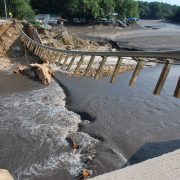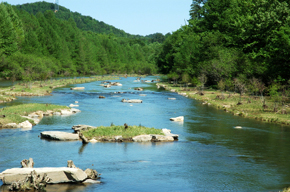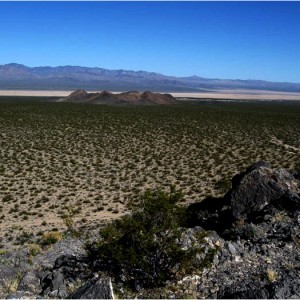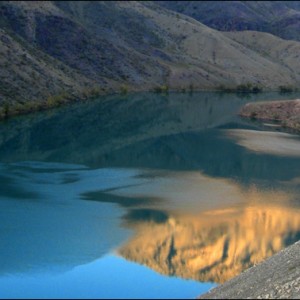Fracking Regulations Vary Widely from State to State
A look at how states across America are facing deep frack dilemmas.
By Steve Kellman and Molly Ramsey
Circle of Blue
Prompted by upgrades in drilling technology and immense reserves of natural gas contained in carbon-rich shales that lies miles deep, a boom in natural gas development is well underway across the United States that is also causing states to scramble to review their drilling regulations and cleanup requirements. At risk is the safety of groundwater that millions of people use in their homes and businesses.
Michigan is the latest state to confront the deep shale gas trend as gas companies snatched up leases earlier this year in the Collingwood Shale formation that lies two miles below the surface under the northern part of the state. A May auction of state mineral leases brought in a record $178 million—nearly as much as the state had earned in the past 82 years of lease sales combined.
State officials said they are prepared for the boom, and are reviewing regulations for spacing the wells, and for managing freshwater supplies to the wells, each of which will use 5 million gallons of water or more.
Michigan has “very strong casing and sealing standards which have been successful in protecting fresh water resources,” according to Tom Wellman, mineral and land management manager at the Department of Natural Resources and Environment (DNRE). Wellman told Circle of Blue that the high cost of drilling the deep horizontal wells needed to tap formations like the Collingwood Shale will limit the number of wells drilled to one every 640 acres—or one square mile—rather than the one well per 80 acres that was common previously.
Hal Fitch, director of the DNRE’s geological survey office, told Circle of Blue that Michigan has a long history with hydraulic fracturing, also known as fracking or hydrofracking, the drilling practice that fractures the shale with water and chemicals under high pressure, since most of the gas drilling in the state has involved the technique. But he noted that the deep horizontal wells being drilled into the Collingwood formation require far more water than was needed to develop shallower Antrim Shale wells, which were largely developed in the 1990s. A successful test well drilled by a subsidiary of Canada’s Encana Corporation in Missaukee County required five million gallons of water, Fitch noted.
The DNRE will examine the potential effect of water withdrawals on the immediate surroundings of a well site, Fitch said, particularly if it is near wetlands or a lake, to assure that the drilling activity does not deplete the aquifer. But the agency does not track the cumulative effects of water withdrawals across a watershed.
Fitch added that the DNRE has not received any reports of groundwater problems due to the recent drilling. The next big state lease sale occurs in October, and will provide officials fresh evidence of the industry’s interest in the Collingwood Shale.
In other states, the natural gas industry has already committed to spend billions on developing shale gas reserves, but have been confronted by civic resistance and political opposition.
As many as 363 trillion cubic feet of natural gas may be recoverable from the mile-deep Marcellus Shale formation that stretches under New York, Pennsylvania, Ohio and West Virginia, according to Penn State geologist Terry Engelder. That’s enough natural gas to supply the entire nation—which consumed 22.8 trillion cubic feet in 2009—for 15 years. The huge reserve excited gas developers, and touched off a backlash from landowners who fear the possibility of poisoned waterways and contaminated drinking wells.
New York has instituted a drilling moratorium, and the U.S. Environmental Protection Agency canceled a public hearing on August 12th after learning that more than 8,000 people might attend. The agency said it was concerned about crowd control and public safety. The EPA’s previous public hearing, in Canonsburg, Pa., drew more than 1,200 people. The EPA plans to reschedule the New York hearing for September.
Accidents
Recent well accidents in Pennsylvania have heightened public alarm.
A June 3 gas well blowout in Clearfield County that sprayed natural gas and wastewater into the air for 16 hours was one such accident. The geyser reached as high as 75 feet, according to press accounts, before an emergency response team flown in from Texas was able to cap the well. The blowout was blamed on untrained personnel and improper control procedures, and the well operators were fined $400,000 and ordered to suspend all well operations in the state for 40 days .
Pennsylvania Changes Its Tune
The states that sit atop the Marcellus Shale formation have taken differing approaches to regulate the gas boom.
Pennsylvania, of course, is the birthplace of the American hydrocarbon development industry. More than 350,000 oil and gas wells have been drilled since the first commercial oil well began production was in 1859. The state began regulating drilling nearly a century later, in 1956 (PDF).
Given its history with the oil and gas industry, Pennsylvania regulators initially reacted nonchalantly to the latest round of development. Ron Gilius, former director of the Pennsylvania Department of Environmental Protection’s Bureau of Oil and Gas Management, was quoted during a 2008 interview with Vanity Fair as saying, “What do you have to be afraid of? It’s only sand and water.”
Meanwhile four months ago, the bureau’s current director, Scott Perry, said, “There has never been any evidence of fracking ever causing direct contamination of fresh groundwater in Pennsylvania or anywhere else,” the Vanity Fair report added, quoting a remark that Perry made to the Scranton Times Tribune.
State regulators are starting to change their tune. John Hangar—secretary of the state’s DEP, and Perry’s boss—told National Public Radio (NPR) in a June 16 story that “gas drilling wastewater is exceptionally polluted. It’s nasty, nasty stuff.”
The department now has a web page devoted to news on the Marcellus Shale formation. The site contains answers to frequently asked questions about the area, descriptions of the regulations governing its development, information for landowners considering leasing their mineral rights to oil and gas companies, and a list of the hazardous components in various hydraulic fracturing solutions.
In August, the DEP fined a division of Marcellus Shale operator Atlas Energy Inc., $97,350 for a December incident in which used hydraulic fracturing fluids escaped from a wastewater pit and contaminated a watershed in Hopewell Township.
“It is unacceptable for drilling companies in Pennsylvania to threaten public safety or harm the environment through careless acts, such as this,” George Jugovic Jr., DEP’s southwest regional director, said in a statement. “The Marcellus Shale offers significant economic opportunities for Pennsylvania, but these companies must adopt operating standards that prevent these sorts of accidents and they must make protecting our water resources a top priority.”
The state’s Environmental Quality Board proposed a series of new rules in May that “updates existing requirements regarding the drilling, casing, cementing, testing, monitoring and plugging of oil and gas wells, and the protection of water supplies.”
Ray Walker, vice president of the Texas-based oil and natural gas company Range Resources and chairman of the Marcellus Shale Coalition, an industry group, told NPR that he welcomes stricter standards.
“It’s always better and cheaper to do it right the first time,” he said. Walker’s company is a major player in Pennsylvania, having been dubbed “King of the Marcellus Shale” by Forbes magazine. In July, the company volunteered to disclose the chemical additives being used in the fracking fluid pumped into its wells, after years of industry resistance to their disclosure.
Despite the industry support, some believe that Pennsylvania’s proposed rules don’t go far enough.
The Sierra Club and Earthjustice, a non-profit public interest law firm, commissioned a review of the rule changes by a petroleum and environmental engineer who recommended 47 ways to strengthen the regulations. The recommended changes include setting stronger standards for the surface casing used to protect freshwater aquifers, and a 24-hour deadline to respond to contamination complaints.
New York Draws a Line in the Sand
New York State, since 2008, has taken a hard line against fracking holding up permits for gas drilling in the state’s portion of the Marcellus Shale formation as the Department of Environmental Conservation (DEC) conducts a review of the practice.
On August 3, the state Senate voted for a moratorium on new wells until May 15, 2011, which would give the DEC more time to finish its review of the practice and issue new permitting guidelines. The proposed moratorium would need to be passed by the state Assembly and signed into law by Governor David Paterson before becoming law.
Farther west, where states have had a longer history with the combination of hydraulic fracturing and horizontal drilling, the industry-friendly state of Wyoming has introduced what the New York Times described (http://www.nytimes.com/2010/07/24/business/energy-environment/24gas.html?pagewanted=2) as “some of the nation’s toughest rules governing fracturing” in June, including requirements that companies disclose the ingredients in their fracking fluids to state regulators. The disclosure requirement was the first in the nation, according to Environment & Energy Publishing.
Still, the new rules to not require that those ingredients be disclosed to the public.
Colorado revamped its oil and gas laws in 2007 to require that companies maintain an inventory of the chemicals used at each well, Environment & Energy Publishing reported. The inventory must be maintained for the life of the well plus an additional five years. While the companies do not have to file the list with state regulators, they are required to provide it to the Colorado Oil and Gas Conservation Commission on request, and the agency can then share the information with health officials or a treating physician under a confidentiality agreement.
Protecting The Water Supply For 15 Million People
State agencies are not the only regulators weighing in on hydraulic fracturing.
The multi-state Delaware River Basin Commission, which oversees the 330-mile Delaware River that flows through New York, Pennsylvania, New Jersey and Delaware, took a tough stance in May 2009, requiring commission approval of any natural gas drilling in the basin. The commission cited concerns that the massive amounts of water required for hydraulic fracturing would deplete the aquifers, that drilling operations could pollute groundwater or surface water, and that the recovered fracking fluids would not be treated and disposed of properly.
More than 15 million people depend on the basin for their drinking water, farming and industrial needs, according to the commission.
States Fill Federal Gap
One reason that states are reviewing their regulations and considering further environmental safeguards is the federal Energy Policy Act of 2005, which specifically exempts fracking from the Safe Water Drinking Act and Clean Water Act. The EPA is now conducting a $1.9 million study of fracking’s effects on water resources as it considers whether additional federal protections should be put in place.
In a recent interview with The Financial Times, the man who helped set off the natural gas boom in Pennsylvania said that passing nationwide regulations governing hydraulic fracturing would be problematic, given the geological variations between regions and the complexity of the industry itself. As many as 200 gas producers are involved in gas shale drilling, Engelder estimated, each with its own set of rules for fracking.
“Industry has to experiment,” Engelder said. “Industry has to learn what went wrong to get it right next time. The industry evolves that way and writing reports is not going to replace the experience of doing this… I would defend the system of free enterprise here.”
Others argue that a more comprehensive regulatory approach is crucial to provide adequate protection to the environment.
Amy Mall, a senior policy analyst with the Natural Resources Defense Council, told the New York Times that hydrofracking and its effects are long overdue for tighter regulation.
“Any one accident might not be on the scale of the Deepwater Horizon disaster,” Mall said. “But accidents are happening all the time, and there’s no regime in place that broadly protects the health of communities and the surrounding environment where drilling is being done.”
Steve Kellman and Molly Ramsey are Michigan-based reporters for Circle of Blue. Reach them at circleofblue.org/contact and mollyr@circleofblue.org.











Leave a Reply
Want to join the discussion?Feel free to contribute!